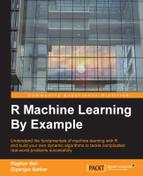This section covers areas related to controlling the execution of your code. Using specific constructs such as if-else and switch, you can execute code conditionally. Constructs like for, while, and repeat, and help in executing the same code multiple times which is also known as looping. We will be exploring all these constructs in the following section.
There are several constructs which help us in executing code conditionally. This is especially useful when we don't want to execute a bunch of statements one after the other sequentially but execute the code only when it meets or does not meet specific conditions. The following examples illustrate the same:
> num = 5 > if (num == 5){ + cat('The number was 5') + } The number was 5 > > num = 7 > > if (num == 5){ + cat('The number was 5') + } else{ + cat('The number was not 5') + } The number was not 5 > > if (num == 5){ + cat('The number was 5') + } else if (num == 7){ + cat('The number was 7') + } else{ + cat('No match found') + } The number was 7 > ifelse(num == 5, "Number was 5", "Number was not 5") [1] "Number was not 5"
The switch function is especially useful when you have to match an expression or argument to several conditions and execute only if there is a specific match. This becomes extremely messy when implemented with the if-else constructs but is much more elegant with the switch function, as we will see next:
> switch( + "first", + first = "1st", + second = "2nd", + third = "3rd", + "No position" + ) [1] "1st" > > switch( + "third", + first = "1st", + second = "2nd", + third = "3rd", + "No position" + ) [1] "3rd" > # when no match, default statement executes > switch( + "fifth", + first = "1st", + second = "2nd", + third = "3rd", + "No position" + ) [1] "No position"
Loops are an excellent way to execute code segments repeatedly when needed. Vectorization constructs are, however, more optimized than loops for working on larger data sets, but we will see that later in this chapter. For now, you should remember that there are three types of loops in R, namely, for, while, and repeat. We will look at all of them in the following examples:
> # for loop > for (i in 1:10){ + cat(paste(i," ")) + } 1 2 3 4 5 6 7 8 9 10 > > sum = 0 > for (i in 1:10){ + sum <- sum + i + } > sum [1] 55 > > # while loop > count <- 1 > while (count <= 10){ + cat(paste(count, " ")) + count <- count + 1 + } 1 2 3 4 5 6 7 8 9 10 > > # repeat infinite loop > count = 1 > repeat{ + cat(paste(count, " ")) + if (count >= 10){ + break # break off from the infinite loop + } + count <- count + 1 + } 1 2 3 4 5 6 7 8 9 10
